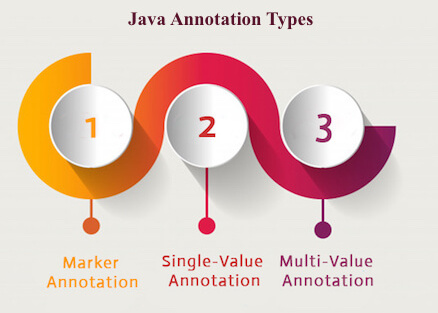- Java4/5 泛型
- Java4/5 断言
- Java4/5 静态import
- Java4/5 可变参数(变量):
- Java4/5 For-each循环
- Java4/5 Autoboxing
- C++中的注释
- C#中的注释
- F#注释
- C++注释(1)
- C#注释
- F#注释(1)
- C++ 注释
- C++注释
- C#注释
- C++ 注释(1)
- C / C++中的注释
- C#中的注释(1)
- c++ 注释 - C++ (1)
- C#注释(1)
- c++中的注释(1)
- C C++中的注释(1)
- Python注释
- python中的注释(1)
- Python注释(1)
- c++代码示例中的注释
- c++ 注释 - C++ 代码示例
- JavaScript注释(1)
- JavaScript注释(1)
📅 最后修改于: 2020-10-13 06:54:36 🧑 作者: Mango
Java注解
Java Annotation是表示元数据的标记,即附加有类,接口,方法或字段的元数据,以指示Java编译器和JVM可以使用的一些附加信息。
Java中的注释用于提供其他信息,因此它是XML和Java标记接口的替代选项。
首先,我们将学习一些内置注释,然后继续创建和使用自定义注释。
内置Java注释
Java中有几个内置注释。一些注释应用于Java代码,而另一些注释则应用于其他注释。
Java代码中使用的内置Java注释
- @Override
- @SuppressWarnings
- @已弃用
其他注释中使用的内置Java注释
- @目标
- @保留
- @遗传
- @记录
了解内置注释
首先让我们了解内置注释。
@Override
@Override注释可确保子类方法将覆盖父类方法。如果不是这样,则会发生编译时错误。
有时,我们会犯一些愚蠢的错误,例如拼写错误等。因此,最好标记@Override注释,以确保方法被覆盖。
class Animal{
void eatSomething(){System.out.println("eating something");}
}
class Dog extends Animal{
@Override
void eatsomething(){System.out.println("eating foods");}//should be eatSomething
}
class TestAnnotation1{
public static void main(String args[]){
Animal a=new Dog();
a.eatSomething();
}}
Output:Comple Time Error
@SuppressWarnings
@SuppressWarnings批注:用于禁止编译器发出的警告。
import java.util.*;
class TestAnnotation2{
@SuppressWarnings("unchecked")
public static void main(String args[]){
ArrayList list=new ArrayList();
list.add("sonoo");
list.add("vimal");
list.add("ratan");
for(Object obj:list)
System.out.println(obj);
}}
Now no warning at compile time.
如果删除@SuppressWarnings(“ unchecked”)批注,由于我们使用的是非通用集合,它将在编译时显示警告。
@已弃用
@Deprecated注释表示此方法已弃用,因此编译器将显示警告。它通知用户它可能会在将来的版本中删除。因此,最好不要使用这种方法。
class A{
void m(){System.out.println("hello m");}
@Deprecated
void n(){System.out.println("hello n");}
}
class TestAnnotation3{
public static void main(String args[]){
A a=new A();
a.n();
}}
在编译时:
Note: Test.java uses or overrides a deprecated API.
Note: Recompile with -Xlint:deprecation for details.
在运行时:
hello n
Java自定义注释
Java自定义注释或Java用户定义的注释易于创建和使用。 @interface元素用于声明注释。例如:
@interface MyAnnotation{}
在这里,MyAnnotation是自定义注释名称。
Java自定义注释Signature(签名)要记住的要点
程序员应该记住一些要点。
- 方法不应包含任何throws子句
- 方法应返回以下之一:原始数据类型,字符串,类,枚举或这些数据类型的数组。
- 方法不应具有任何参数。
- 我们应该在接口关键字之前附加@来定义注释。
- 它可以为该方法分配默认值。
注释类型
有三种类型的注释。
- 标记注释
- 单值注释
- 多值注释

1)标记注释
没有方法的注释称为标记注释。例如:
@interface MyAnnotation{}
@Override和@Deprecated是标记注释。
2)单值注释
具有一种方法的注释称为单值注释。例如:
@interface MyAnnotation{
int value();
}
我们也可以提供默认值。例如:
@interface MyAnnotation{
int value() default 0;
}
如何应用单值注释
让我们看一下应用单值注释的代码。
@MyAnnotation(value=10)
该值可以是任何值。
3)多值注释
具有多种方法的注释称为多值注释。例如:
@interface MyAnnotation{
int value1();
String value2();
String value3();
}
}
我们也可以提供默认值。例如:
@interface MyAnnotation{
int value1() default 1;
String value2() default "";
String value3() default "xyz";
}
如何应用多值注释
让我们看一下应用多值注释的代码。
@MyAnnotation(value1=10,value2="Arun Kumar",value3="Ghaziabad")
Java自定义注释中使用的内置注释
- @目标
- @保留
- @遗传
- @记录
@目标
@Target标记用于指定使用哪种类型的注释。
java.lang.annotation.ElementType枚举声明了许多常量以指定要在其中应用注释的元素的类型,例如TYPE,METHOD,FIELD等。让我们来看一下ElementType枚举的常量:
| Element Types | Where the annotation can be applied |
|---|---|
| TYPE | class, interface or enumeration |
| FIELD | fields |
| METHOD | methods |
| CONSTRUCTOR | constructors |
| LOCAL_VARIABLE | local variables |
| ANNOTATION_TYPE | annotation type |
| PARAMETER | parameter |
为类指定注释的示例
@Target(ElementType.TYPE)
@interface MyAnnotation{
int value1();
String value2();
}
为类,方法或字段指定注释的示例
@Target({ElementType.TYPE, ElementType.FIELD, ElementType.METHOD})
@interface MyAnnotation{
int value1();
String value2();
}
@保留
@Retention批注用于指定注释级别。
| RetentionPolicy | Availability |
|---|---|
| RetentionPolicy.SOURCE | refers to the source code, discarded during compilation. It will not be available in the compiled class. |
| RetentionPolicy.CLASS | refers to the .class file, available to java compiler but not to JVM . It is included in the class file. |
| RetentionPolicy.RUNTIME | refers to the runtime, available to java compiler and JVM . |
指定RetentionPolicy的示例
@Retention(RetentionPolicy.RUNTIME)
@Target(ElementType.TYPE)
@interface MyAnnotation{
int value1();
String value2();
}
自定义注释的示例:创建,应用和访问注释
让我们看一下创建,应用和访问注释的简单示例。
文件:Test.java
//Creating annotation
import java.lang.annotation.*;
import java.lang.reflect.*;
@Retention(RetentionPolicy.RUNTIME)
@Target(ElementType.METHOD)
@interface MyAnnotation{
int value();
}
//Applying annotation
class Hello{
@MyAnnotation(value=10)
public void sayHello(){System.out.println("hello annotation");}
}
//Accessing annotation
class TestCustomAnnotation1{
public static void main(String args[])throws Exception{
Hello h=new Hello();
Method m=h.getClass().getMethod("sayHello");
MyAnnotation manno=m.getAnnotation(MyAnnotation.class);
System.out.println("value is: "+manno.value());
}}
Output:value is: 10
在实际场景中如何使用内置注释?
在实际情况下,Java程序员只需要应用注释。他/她不需要创建和访问注释。创建和访问注释由实现提供者执行。代表注释,java编译器或JVM执行一些其他操作。
@遗传
默认情况下,注释不继承到子类。 @Inherited批注将批注标记为要继承到子类。
@Inherited
@interface ForEveryone { }//Now it will be available to subclass also
@interface ForEveryone { }
class Superclass{}
class Subclass extends Superclass{}
@记录
@Documented标记要包含在文档中的注释。